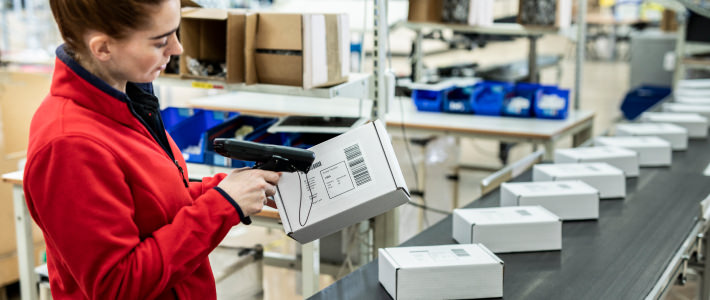Get 2-inch printing fit to your work with endurance to handle everyday hazards.
Warehouse automation is creating the new normal. As businesses in the warehousing and manufacturing industries plan for 2023 and beyond, one trend continues to dominate: warehouse automation.
When the supply chain world turned upside down during the pandemic, warehouse automation became a go-to solution for some of the industry’s biggest challenges. Now, it’s quickly becoming standard operating procedure.
Why? Labor shortages and supply chain disruption show no signs of going back to normal—or at least, not the normal we were used to. Here are two key reasons:
Even in hard times, warehouse work is a hard sell
There are a lot of open warehouse positions, and filling them is getting increasingly difficult. Even with higher wages, hiring bonuses, and robust benefits packages, the talent pool just isn’t that interested in traditional warehouse work.
Traditionally, the hours are long and the tasks can be tedious, or physically taxing. The current talent pool wants more from their work.
Read more: 3 Ways to Stay Ahead of Warehouse Labor Shortages
The supply chain doesn’t operate like it used to
Production costs are high and material goods are difficult to obtain with the regularity and speed eCommerce demands. Customers expect more visibility into the order process, 100% order accuracy, and faster shipping, all of which requires a full, and fully dependable, staff. Lets look at the seven key warehouse automation solutions that can make this possible for your operation.

1. Considerations for embracing warehouse automation
Automated warehousing solutions are designed to solve both these problems at once by speeding up production and eliminating redundant processes that previously required a lot of time and manual labor.
Production lines are more productive; warehouse work is more interesting (and safe) for workers. Win-win.
With such obvious benefits, embracing warehouse automation technology is no longer a question of “if” or “when”. With the global warehouse automation market forecasted to exceed 30 billion dollars by 20261, that ship is sailing full speed ahead.
These are the bigger considerations for your business, especially if you’re just starting to explore this trend in earnest:
- What does automation actually entail?
- What will automation cost me?
- What processes can I automate in my warehouse?
- How do I get started?
Download the eBook to learn more about the six tools you may see in automated warehouses.

2. Beyond the robots: Exploring basic warehouse automation
Warehouse automation is the process of delegating error-prone, labor-intensive processes to technologies that don’t require constant human oversight. Contrary to science-fiction, the purpose is not to take humans off the job altogether. Rather, the goal is to streamline and eliminate the tedious, repetitive tasks that humans generally prefer not to do anymore.
Getting to a fully automated warehouse is a journey with two primary pathways: digital, and physical. There are a lot of warehouse automation trends to get excited about on both fronts. For the purposes of this article, we’ll focus on the ones that are in the realm of possibility for most warehouses.
Read more: 3 Practical Strategies to Keep Up with Warehousing Market Growth

3. Digital warehouse automation
Warehouse management software (WMS) has always been the first step towards automation. But WMS has come a long way since the 90s. Today’s software prioritizes wireless connectivity, inventory management automation, and real-time data that allows for total visibility and flexibility on the warehouse floor.
Digital warehouse automation solutions
- Cloud-based warehouse management systems.
- Predictive maintenance software.
- Digital barcoding systems.
- Data analytics platforms.
With digital automation, data does the heavy lifting and inventory insights are at your fingertips. And with the popularity of software as a service (SaaS), there are plenty of opportunities to take the plunge on these new systems without a massive, permanent investment up-front.

4. Physical warehouse automation
Digital optimization lays the foundation for better operational efficiencies, physical automation facilitates the execution. For physical automation, the focus is on tools, machinery and systems that take physical strain off your staff and optimize inventory movements across all warehouse zones.
Physical warehouse automation solutions
- Mobile tablets, barcode scanners and printers.
- Goods-to-person picking systems.
- Pick-to-light and put-to-light systems.
- Automated sortation systems.
All of the above are designed to work in concert with your WMS to speed up processes without extensive manual oversight. The most practical and essential building block is an efficient barcoding system that integrates with your WMS. With that established, you can start build a digital framework that makes more efficient systems possible without hefty upfront costs.
Do you know the real cost of manual processes? Discover how they can impact warehouse managers, material handlers, and customers by reading the eBook.

5. Processes that can benefit from warehouse automation
So where exactly can you start automating? Exactly where you need to most.
- Receiving
- Put-away
- Storage
- Picking
- Packing
- Shipping
Any one of these processes can benefit from putting essential but repetitive tasks on autopilot. Less error, more consistency, no boredom necessary.
Read more: 7 Tips to Speed Productivity at the Receiving Dock

6. How to start implementing warehouse automation technology
Innovations in the warehousing market are pushing the industry in exciting new directions. But as with most emergent technologies, costs are high and implementation can be complex. This is especially true for smaller warehouses with legacy systems in need of an overhaul.
But just because you aren’t ready to invest in cutting-edge robotics and AI doesn’t necessarily mean you’re in danger of lagging. There are types of warehouse equipment that are far more accessible financially and, more importantly, far easier to start integrating.
Even if cost is no barrier, experiencing the benefits of warehousing automation doesn’t happen automatically.
Your most important investment is reviewing your internal processes and identifying which parts of your operation could benefit from an upgrade most.
Read the eBook to discover three ways you can start automating your warehouse right now.
7. Keep it simple—start small
True innovation comes from getting creative with what you have. Consider that your first step.
Interested in getting started?
Download our eBook to learn you can take small, manageable steps to start experiencing the benefits of warehouse automation now.







